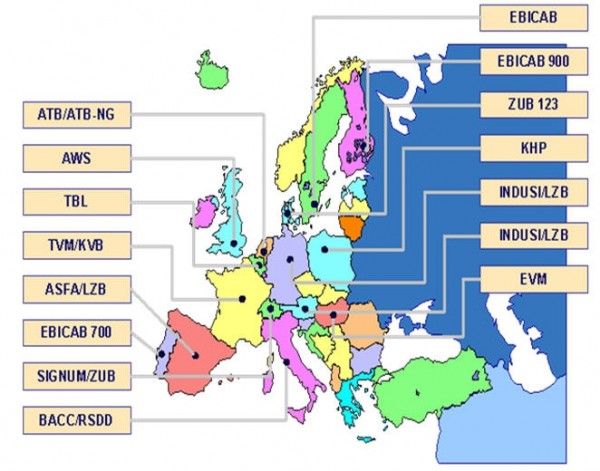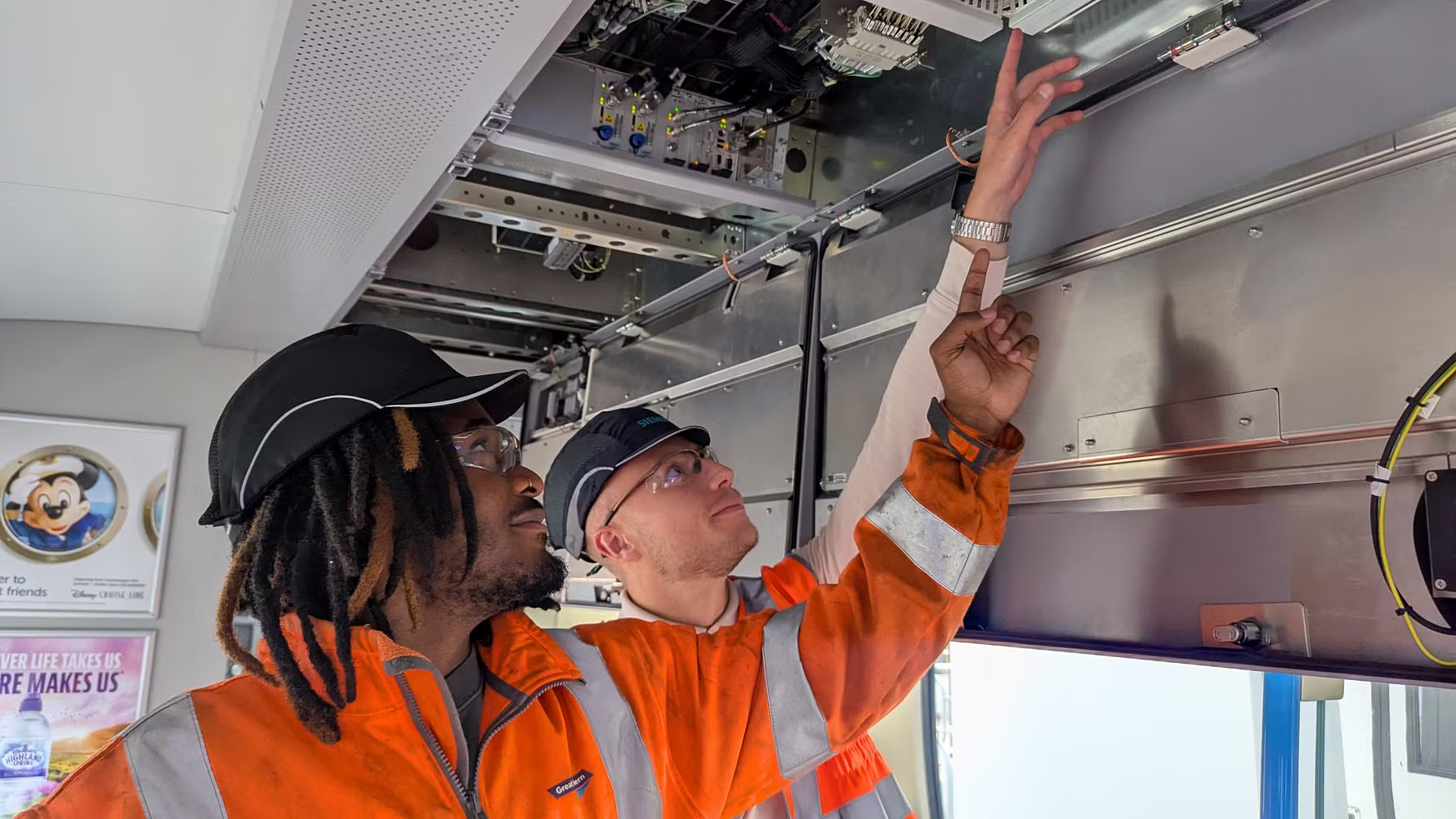ETCS for ÖBB: The beginning of a new train control era in Austria
Posted: 4 August 2011 | | 2 comments
After years of preparation and comprehensive calls for tenders from suppliers, Austrian Federal Railways (ÖBB) has placed all orders for the implementation of the European Train Control System (ETCS). In February 2010 the final purchase order was placed, concerning system integration. During the past two years, a company-wide programme group has been working on the implementation of ETCS in Austria. This marks the beginning of a new era in automated train control and protection for ÖBB and is simultaneously a further step towards deregulated and efficient rail traffic throughout Europe.
Harmonised standards thanks to ERTMS
Due to the many differences in the historic development of national railways in Europe, various non-compatible train control systems have emerged (see Figure1). This circumstance has impaired cross-border traffic and poses a significant operational and economic obstacle for the railways, especially with regard to the European common market. The EU has therefore been keen to standardise and deregulate train services throughout Eu
After years of preparation and comprehensive calls for tenders from suppliers, Austrian Federal Railways (ÖBB) has placed all orders for the implementation of the European Train Control System (ETCS). In February 2010 the final purchase order was placed, concerning system integration. During the past two years, a company-wide programme group has been working on the implementation of ETCS in Austria. This marks the beginning of a new era in automated train control and protection for ÖBB and is simultaneously a further step towards deregulated and efficient rail traffic throughout Europe. Harmonised standards thanks to ERTMS Due to the many differences in the historic development of national railways in Europe, various non-compatible train control systems have emerged (see Figure1). This circumstance has impaired cross-border traffic and poses a significant operational and economic obstacle for the railways, especially with regard to the European common market. The EU has therefore been keen to standardise and deregulate train services throughout Eu
After years of preparation and comprehensive calls for tenders from suppliers, Austrian Federal Railways (ÖBB) has placed all orders for the implementation of the European Train Control System (ETCS). In February 2010 the final purchase order was placed, concerning system integration. During the past two years, a company-wide programme group has been working on the implementation of ETCS in Austria. This marks the beginning of a new era in automated train control and protection for ÖBB and is simultaneously a further step towards deregulated and efficient rail traffic throughout Europe.
Harmonised standards thanks to ERTMS
Due to the many differences in the historic development of national railways in Europe, various non-compatible train control systems have emerged (see Figure1). This circumstance has impaired cross-border traffic and poses a significant operational and economic obstacle for the railways, especially with regard to the European common market. The EU has therefore been keen to standardise and deregulate train services throughout Europe – with the goal of establishing interoperable and efficient crossborder rail traffic for all operating companies.


Figure 1 The different train control systems used in Europe Credit: ÖBB
In order to harmonise train control and signalling systems, EU-wide standards have been defined: the train control system ETCS, the Global System for Mobile Communication – Railway (GSM-R) and sections of the Technical Specifications for Interoperability (TSI) together form the European Rail Traffic Management System (ERTMS).
In order to implement the integration of the different national systems into the ERTMS, the EU has obligated all member states to use ETCS and GSM-R for the construction of new railway lines or the extension of existing, trans-European routes. This technology leap, however, is associated with substantial organisational requirements and high costs. For many EU member states and railway companies, such a conversion is therefore not immediately possible and the entire transition period from the old national systems to the harmonised new standards may take up to 30 years.
ÖBB on the path to ETCS
In a transit country such as Austria, interoperable freight and passenger traffic is of great significance. An initial step towards cross-border interoperability was made with the acquisition of the Class 1014 locomotives. However, the operational limits of such vehicle deployments quickly became apparent. Although the locomotives were fully compatible with the different voltages and frequencies of other international networks, train control and radio communications systems could not be made interoperable. In order to achieve this, a modern, multi-system vehicle would have to be equipped with up to 10 separate national train control systems. Similar problems also exist with analogue radio communications, for which there are multiple systems in use in Europe.
For these reasons, ÖBB has followed the international development of ETCS with great interest, both on a UIC and EU level. ÖBB formed a consortium with Hungarian State Railways (MÁV) for the 4th EU framework programme with the specific project ‘European Train Control System for the Vienna–Budapest Line’. Already during the mid-1990s, the ÖBB board had decided to conduct a series of ETCS Level 1 tests on a pilot route in Austria. Between 15th October and 19th November 1999, the new train control system was tested on a 20km line segment of the Wien–Budapest route between the Austrian station of Parndorf and Hegyeshalom in Hungary, with ETCS equipment supplied by Alcatel.
ÖBB installed the infrastructure with more than 30 signals along the test track and provided the ETCS-equipped locomotive 1014.015, specially fitted at the ÖBB workshop in Linz with an onboard European Vital Computer (EVC), an antenna for receiving the signals from the infrastructure, speed indicator displays and a Driver Machine Interface (DMI). The ETCS equipment for the locomotive was provided by Alstom and installed by ÖBB-Technische Services GmbH.
The trials between Parndorf and Mosonmagyaróvár tested the entire spectrum of ETCS Level 1 functions. About 6,000 test kilometres were completed. The border crossing to Hungary did not require any stops and could be completed using ETCS Level 1 throughout, as the ÖBB national standards were smoothly converted to MÁV standards via data telegrams from the installed transponders. In total, approximately €2.4 million were invested in the project, with ÖBB contributing €170,000. Fifty per cent of the ÖBB share was subsidised by the European Union.
Based on these initial trials, ÖBB decided to equip the entire Ostbahn from Wien Zentralverschiebebahnhof (central shunting yard) to Nickelsdorf with ETCS Level 1, version 2.2.2. At the same time, MÁV decided to also fit the entire line from the Austrian border to Budapest Kelenföld with ETCS Level 1, version 2.2.2. After an EU-wide tender, contracts for the supply of ETCS equipment for track infrastructure and locomotives were awarded to Alcatel and Siemens. Simultaneously, the ÖBB multi-system locomotives 1116.01 – 13, which had already been fitted with both the Austrian PZB and the Hungarian EVM 120 train control systems, were retrofitted with ETCS Level 1.
After a long period of intensive tests on the first Level-1 route, starting in 2000, the first operational trials began with four locomotives in July 2006, at that stage still without the implementation of EVM 120. After all the conditions of the Austrian Ministry of Transport had been met regarding track infrastructure and following additional adjustments based on newly-gained operational experience, including the full integration of EVM 120 into the ETCS processor, commercial service was able to begin in 2008.
Based on this direct participation in the development and deployment of ERTMS, as well as through the intensive test phase of ETCS Level 1, ÖBB has been able to acquire significant know-how: its ETCS expertise is now much in demand internationally, helping to secure the long-term technological leadership of ÖBB.
ETCS roll-out
In 2006, the ÖBB board decided to prepare the planning and implementation of ETCS on the main lines of the Austrian network.
In an extensive project involving all ÖBB divisions as well as an external consultant, the further strategy for the ETCS roll-out was defined. The strategy group completed its work on 18th November 2008 and designated those lines which were to be fitted with ETCS by 2020. It also evaluated financing options and subsidy possibilities for the designated ETCS routes plus required traction vehicles. The group decided to implement ETCS Level 2 on all new lines as well as on those existing lines that featured compatible signal boxes. Those lines that were deemed to have strategic importance as transit corridors or required ETCS as important principal axes in the medium term, yet lacked the technical requirements to permit the installation of Level 2, were equipped with Level 1.
These strategic guidelines led in 2008 to the decision to fit the new lines Hadersdorf– St. Pölten and the Brenner corridor (Kufstein–Brenner, including the newly built section) with ETCS Level 2 without signals. Additionally it was decided to fit the existing lines Hadersdorf–St. Pölten, Wels–Passau and Attnang-Puchheim–Salzburg with Level 1.
Due to a detailed risk assessment based on operational ETCS experience from Switzerland and the Netherlands, the board of ÖBB-Infrastruktur AG decided to modify the ETCS decision in December 2009 and implement a fall-back strategy for the newly built lines. In order to better manage potential technological problems relating to the deployment of ETCS by the end of 2012, the new lines will therefore be fitted with fewer track-side signals, placed at wider intervals of about 5,000m. After a planned observation period of three years, the signals will be removed and replaced by shortened 1,000m block sections to ensure maximum route capacity.
Corporate programme ETCS Level 2
For the realisation of its ambitious ETCS Level 2 plans, the ÖBB board decided to launch a company-wide programme which started on 30th April 2008. Unlike the SBB which created a separate department for the implementation of ETCS in Switzerland, ÖBB has put in place a special programme team. The goal of this approach is to foster and intensify companywide knowledge acquisition and know-how transfer. The ÖBB ETCS programme consists of four different project groups for operational management, infrastructure, GSM-R and traction vehicles, respectively.
As part of a Europe-wide tender, ÖBB first had to find suitable industry partners for the supply of ETCS Level 2 equipment for the entire Austrian segment of the ERTMS rail traffic corridor ‘B’ Stockholm–Napoli as well as for the new line Wien–St. Pölten. The Thales Group was subsequently awarded the contract for all Level 2 route equipment, supplying the version 2.3.0d which is presently considered the industry standard. The project must be completed for the timetable changeover in 2012.
Before a tender could be launched for the necessary vehicle equipment, it had to be defined which locomotives would be retrofitted with ETCS Level 2. Only the latest generation of passenger long-distance and freight vehicles were considered suitable for upgrading: the Taurus Classes 1016, 1116 and 1216 and the railjet driving trailers (numbers 80-90…) are to be fitted with ETCS 2.3.0d by 2015. ÖBB awarded this contract to Alstom in December 2009. The deal includes an option for a later update to version 3.0.0. Additionally, Deutsche Bahn (DB) has launched an ETCS equipment tender for the three ÖBB-owned ICE-T units (Class 4011) as well as for 12 of DB’s own ICEs (Class 411).
Once this route and vehicle equipment is in place, a large portion of international rail traffic can then be managed with ETCS. For ÖBB, this will bring decisive advantages. By changing over to ETCS, ÖBB-Infrastruktur AG can offer:
- All railway operators an attractive and optimally available infrastructure
- More capacity for shifting freight traffic from road to rail
- Optimised and therefore efficient use of the capacities of existing routes.
Furthermore, the use of such a modern train control system as ETCS provides significant improvement in operational safety and a marked reduction of residual risk.
About the Author
Stefan Rameder has worked at Austrian Railways since 1977 where he has held positions in various divisions such as Traction and Infrastructure Safety Management. Stefan is now responsible for system integration in the ÖBB ETCS programme.
OUT NOW: The Definitive Guide to Rail’s Digital Future
The rail industry is undergoing a digital revolution, and you need to be ready. We have released our latest market report, “Track Insight: Digitalisation.”
This is not just another report; it’s your comprehensive guide to understanding and leveraging the profound technological shifts reshaping our industry. We move beyond the buzzwords to show you the tangible realities of AI, IoT, and advanced data analytics in rail.
Discover how to:
- Optimise operations and maintenance with real-time insights.
- Enhance passenger services through seamless, high-speed connectivity.
- Leverage technologies like LEO satellites to improve safety and efficiency.
Featuring expert analysis from leaders at Nomad Digital, Lucchini RS, Bentley Systems and more, this is a must-read for any rail professional.








Dear Mr Rameder,
I’m an Italian engineer and have read a lot about your sistem.
I had a different approach (patent pending) that is mainly a “distributed” system; i.e. the information is exchanged, on local scale, among trains and stations. Trains moving between stations and stations at boundary of tracks (minimum). It is an approach intended to avoid accidents (collisions, workers on track, level crossings, etc.)
I know that anything “new” or “different” does not encounter the favors of the specialists, but I would like to listen the opinion of experts. Are you available to read a presentation I made? If yes could you please provide an e-mail address?
Many thanks for any reply you will provide.
Gianantonio Moretto
Dear Mr Stefan Rameder
By Slovenien railway want to prepare on ETCS.
Are you ready to inform us with your experiance,
We ask you kindly for a meeting in Januar or Februar 2018
Petrovič